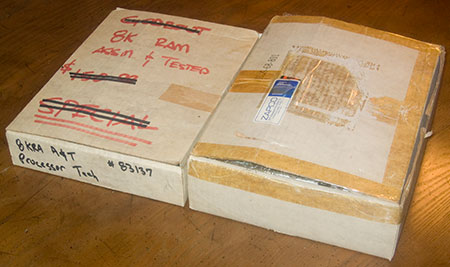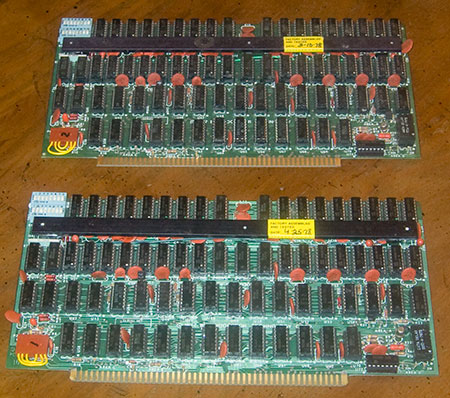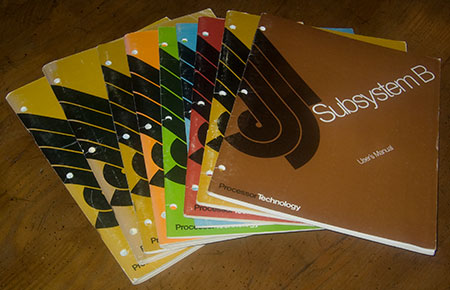I located my Sol Archives in my storage vault, so I figured I would celebrate by recording the unboxing. Even the cardboard boxes are a trip through microcomputer history.

These two modest boxes enclose all my Sol programs and manuals. One box is labeled "Godbout 8K RAM Assm & Tested $150 SPECIAL" on the top, and "8KRA A&T Processor Tech." Well I don't have either of those products, but just seeing the name Godbout was trip down memory lane, they were one of the earliest manufacturers of S-100 memory boards. But let's see what is in the boxes.

Ah, there's my old cassette tapes, with all the major apps I purchased from Processor Tech and other companies, along with tapes of all the programs I wrote myself. Some of them have intriguing labels in my own handwriting like "3D Graphics." Ooh I wonder what that is. I'll find out soon enough. Let's open the second box and see what's inside.

Manuals. The Extended Cassette Basic manual was my favorite resource for years and years. I wrote a lot of programs in Extended Basic on my Sol, it was sufficiently close to ANSI Basic that I could write and test them locally and then upload them by modem to minicomputers on our campus network. But wait, there's more.

These are my two precious 16KRA memory boards. Larger programs like Extended Basic required more memory than the motherboard of the Sol contained, so bought new memory as I could afford it, finally bringing the total up to a massive 32k. These two boards have the date of manufacture on a label, 3/10/78 and 4/25/78, so I obviously bought these a couple of years after I built my Sol in 1976.

And now the final part of the archives, Sol manuals. There's one particularly good manual, the "Subsystem B User Manual." I don't know why I have this manual since I don't actually own a Subsystem B. I must have gotten it from my Sol dealer. Subsystem B was a set of circuit boards for other S-100 computers like the IMSAI or Altair, it would effectively turn your computer into a Sol. For a brief while, the Sol display and I/O system was a standard, but it was quickly surpassed by other systems with higher resolution and more features. Most of the Sol manuals have been scanned and archived on the web, but not this Subsystem B manual. This is definitely a rarity and may be the only surviving copy.
There are a few bits missing from my Sol archives that are not pictured here. Somewhere in my house is the huge black binder that contains all the assembly instructions. I also have a beautiful advertising poster for the Sol, but it's wrapped up in a bundle of other large artworks that I really don't want to open up right now.
So that's my Sol Archives. Now I have to plug in the memory boards and start fiddling around with the programs on tape. But that story will have to wait for another day.

These two modest boxes enclose all my Sol programs and manuals. One box is labeled "

Ah, there's my old cassette tapes, with all the major apps I purchased from Processor Tech and other companies, along with tapes of all the programs I wrote myself. Some of them have intriguing labels in my own handwriting like "3D Graphics." Ooh I wonder what that is. I'll find out soon enough. Let's open the second box and see what's inside.

Manuals. The Extended Cassette Basic manual was my favorite resource for years and years. I wrote a lot of programs in Extended Basic on my Sol, it was sufficiently close to ANSI Basic that I could write and test them locally and then upload them by modem to minicomputers on our campus network. But wait, there's more.

These are my two precious 16KRA memory boards. Larger programs like Extended Basic required more memory than the motherboard of the Sol contained, so bought new memory as I could afford it, finally bringing the total up to a massive 32k. These two boards have the date of manufacture on a label, 3/10/78 and 4/25/78, so I obviously bought these a couple of years after I built my Sol in 1976.

And now the final part of the archives, Sol manuals. There's one particularly good manual, the "Subsystem B User Manual." I don't know why I have this manual since I don't actually own a Subsystem B. I must have gotten it from my Sol dealer. Subsystem B was a set of circuit boards for other S-100 computers like the IMSAI or Altair, it would effectively turn your computer into a Sol. For a brief while, the Sol display and I/O system was a standard, but it was quickly surpassed by other systems with higher resolution and more features. Most of the Sol manuals have been scanned and archived on the web, but not this Subsystem B manual. This is definitely a rarity and may be the only surviving copy.
There are a few bits missing from my Sol archives that are not pictured here. Somewhere in my house is the huge black binder that contains all the assembly instructions. I also have a beautiful advertising poster for the Sol, but it's wrapped up in a bundle of other large artworks that I really don't want to open up right now.
So that's my Sol Archives. Now I have to plug in the memory boards and start fiddling around with the programs on tape. But that story will have to wait for another day.
I remember explaining to my kids 10 years ago how I used to store my programs on cassette tape before there were floppy disks. They will need to explain to their kids what a floppy disk is. By the way, love your SOL pics and blog. Nostalgic.
Did you ever get the SOL running. I bet there is some interesting programs in those cassettes too. Would be great to get digital backups of your programs...Hint hint.
[Yes, I did get the old SOL running.. sort of. I restored the keyboard and the CPU is running perfectly, but I can't get the RAM boards to work. You can read about it here, elsewhere on my blog. So currently, I can't actually run any programs. This is disappointing, but I am looking for a replacement RAM board. Occasionally they appear on eBay, so eventually I will find one. Most of the SOL software can be downloaded from the SOL-20 Archive, but of course, all the programs I wrote myself are still on tape, and I can't load them until I get the RAM working --Charles]